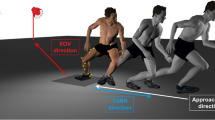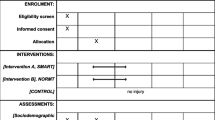Abstract
With lateral ankle sprains being the most frequent sports-related injury, there is an evident demand for the preventive measures in active individuals with chronic ankle instability. Braces are commonly used for prevention and treatment of ankle injuries. Various investigations—mostly performed with healthy subjects—focused on this problem, yet they often compared only a few models or used only limited testing procedures. However, controversy exists whether braces affect sports performance. The purpose of the present study was to compare the effects of ten different ankle braces—one rigid, five semirigid, four soft models—in a comprehensive evaluation with multiple testing procedures in 34 subjects with self-reported chronic ankle instability. The multiple testing procedures evaluated objective performance-related parameters and subjective parameters related to comfort and stability. The subjects performed an agility course with maximal effort. The course included a vertical jump and a cutting maneuver, both on a force platform, a single leg hopping test on level and inclined plates, a combined straight and curve sprint and sidesteps. Three valid trials were measured and averaged for each brace and every subject. Subjective aspects were evaluated with a questionnaire about handling, perceived restrictions, support and comfort; it was completed after each brace was worn and tried. With regard to the objective parameters, no significant differences were found between the braces except for the rigid brace which showed decreased values for the vertical jump and longer times for the other tests compared to all other braces. The subjective evaluation of the braces revealed significant differences with respect to comfort and handling and therefore, permitted a distinction between semirigid and soft braces. Although significant differences between braces were found in subjective performance restriction, no significant differences were revealed in the objective evaluation. From that point of view, patients could choose a brace model according to their individual needs. A comfortable brace might have a positive influence on the athlete’s state of mind although other aspects like the brace’s stabilizing effect play an additional role and should also be taken into account for recommendation of braces.



Similar content being viewed by others
References
Alves JW, Alday RV, Ketcham DL, Lentell GL (1992) A comparison of the passive support provided by various ankle braces. J Orthop Sports Phys Ther 15:10–18
Backx FJ, Beijer HJ, Bol E, Erich WB (1991) Injuries in high-risk persons and high-risk sports. A longitudinal study of 1818 school children. Am J Sports Med 19:124–130
Beriau MR, Cox WB, Manning J (1994) Effects of ankle bracing upon agility course performance in high school athletes. J Athletic Training 29:224–230
Beynnon BD, Renström PA, Alosa DM, Baumhauer JF, Vacek PM (2001) Ankle ligament injury risk factors: a prospective study of college athletes. J Orthop Res 19:213–220
Bot SD, van Mechelen W (1999) The effect of ankle bracing on athletic performance. Sports Med 27:171–178
Burks RT, Bean BG, Marcus R, Barker HB (1991) Analysis of athletic performance with prophylactic ankle devices. Am J Sports Med 19:104–106
Eils E, Demming C, Kollmeier G, Thorwesten L, Volker K, Rosenbaum D (2002) Comprehensive testing of 10 different ankle braces. Evaluation of passive and rapidly induced stability in subjects with chronic ankle instability. Clin Biomech 17:526–535
Frick U, Schmidtbleicher D, Wörn C (1991) Vergleich biomechanischer Messverfahren zur Bestimmung der Sprunghöhe bei Vertikalsprüngen. Leistungssport 2:48–53
Greene TA, Hillman SK (1990) Comparison of support provided by a semirigid orthosis and adhesive ankle taping before, during, and after exercise. Am J Sports Med 18:498–506
Gross MT, Clemence LM, Cox BD, McMillan HP, Meadows AF, Piland CS, Powers WS (1997) Effect of ankle orthoses on functional performance for individuals with recurrent lateral ankle sprains. J Orthop Sports Phys Ther 25:245–252
MacKean LC, Bell G, Burnham RS (1995) Prophylactic ankle bracing vs. taping: effects on functional performance in female basketball players. J Orthop Sports Phys Ther 22:77–81
Mangwani J, Hakmi MA, Smith TWD (2001) Chronic lateral ankle instability: review of anatomy, biomechanics, pathology, diagnosis and treatment. The Foot 11:76–84
Renström P, Theis M (1993) Die Biomechanik der Verletzungen der Sprunggelenkbänder. Sportverl Sportschad 7:29–35
Thacker SB, Stroup DF, Branche CM, Gilchrist J, Goodman RA, Weitman EA (1999) The prevention of ankle sprains in sports—a systematic review of the literature. Am J Sports Med 27:753–760
Verhagen EA, van der Beek AJ, van Mechelen W (2001) The effect of tape, braces and shoes on ankle range of motion. Sports Med 31:667–677
Acknowledgments
Thanks are due to the manufacturers for providing the braces and financial support of the study and to Nike Inc. for providing the shoes for the tests.
Author information
Authors and Affiliations
Corresponding author
Rights and permissions
About this article
Cite this article
Rosenbaum, D., Kamps, N., Bosch, K. et al. The influence of external ankle braces on subjective and objective parameters of performance in a sports-related agility course. Knee Surg Sports Traumatol Arthrosc 13, 419–425 (2005). https://doi.org/10.1007/s00167-004-0584-7
Received:
Accepted:
Published:
Issue Date:
DOI: https://doi.org/10.1007/s00167-004-0584-7




